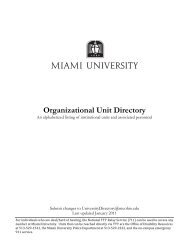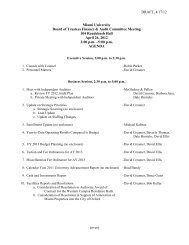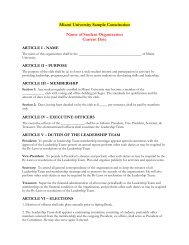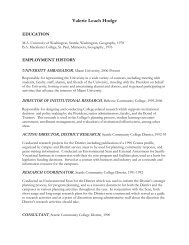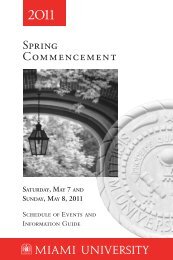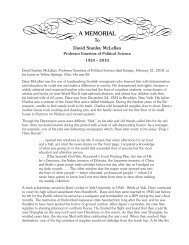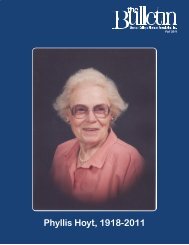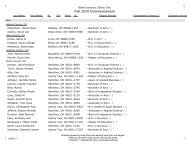Developing the Student as Scholar in a ... - Miami University
Developing the Student as Scholar in a ... - Miami University
Developing the Student as Scholar in a ... - Miami University
You also want an ePaper? Increase the reach of your titles
YUMPU automatically turns print PDFs into web optimized ePapers that Google loves.
From Inquiry to Discovery:<strong>Develop<strong>in</strong>g</strong> <strong>the</strong> <strong>Student</strong> <strong>as</strong><strong>Scholar</strong> <strong>in</strong> a Networked WorldLearn<strong>in</strong>g Through Enquiry Alliance (LTEA)Conference 2008“Inquiry <strong>in</strong> a Networked World”Wednesday 25th – Friday 27th June 2008<strong>University</strong> of SheffieldDavid Hodge, <strong>Miami</strong> <strong>University</strong>Carolyn Haynes, <strong>Miami</strong> <strong>University</strong>Paul LePore, <strong>University</strong> of W<strong>as</strong>h<strong>in</strong>gtonKira P<strong>as</strong>quesi, Colorado CollegeMarissa Hirsh, <strong>Miami</strong> <strong>University</strong>
undergraduates, but it also requires a culture of <strong>in</strong>quiry-b<strong>as</strong>ed learn<strong>in</strong>g <strong>in</strong>fused throughout <strong>the</strong>entire liberal arts curricular and co-curricular experience that starts with <strong>the</strong> very first day ofcollege and is re<strong>in</strong>forced <strong>in</strong> every cl<strong>as</strong>sroom and program. Put ano<strong>the</strong>r way, <strong>the</strong> <strong>Student</strong> <strong>as</strong><strong>Scholar</strong> Model represents <strong>the</strong> far end of <strong>the</strong> educational spectrum, specifically progress<strong>in</strong>g froman <strong>in</strong>structional paradigm that emph<strong>as</strong>izes tell<strong>in</strong>g students what <strong>the</strong>y need to know, to a learn<strong>in</strong>gparadigm that emph<strong>as</strong>izes <strong>in</strong>quiry <strong>in</strong> shap<strong>in</strong>g how students learn what <strong>the</strong>y need to know with<strong>in</strong><strong>the</strong> traditional academic context, and culm<strong>in</strong>at<strong>in</strong>g <strong>in</strong> a discovery paradigm that encouragesstudents to seek and discover new knowledge, emph<strong>as</strong>iz<strong>in</strong>g <strong>in</strong>quiry with no boundaries.At its core, this is a vision of undergraduate education that offers students susta<strong>in</strong>ed andconsistent emph<strong>as</strong>is on <strong>the</strong>ir identity <strong>as</strong> learners and <strong>as</strong> scholars, gradually blurr<strong>in</strong>g <strong>the</strong>dist<strong>in</strong>ction between <strong>the</strong> two; and it provides opportunities to develop mean<strong>in</strong>gful connections tofaculty, staff, and o<strong>the</strong>r students <strong>in</strong> campus environments that establish and support vibrantlearn<strong>in</strong>g communities. Yet, susta<strong>in</strong><strong>in</strong>g this emph<strong>as</strong>is on students <strong>as</strong> scholars and mean<strong>in</strong>gfulconnections among faculty and students, we must understand <strong>the</strong> way that students develop anddesign our learn<strong>in</strong>g environments to <strong>as</strong>sist <strong>the</strong>ir movement from a more p<strong>as</strong>sive, externallymotivated learner to <strong>the</strong> active, <strong>in</strong>ternally-motivated posture of a scholar.In this paper we first exam<strong>in</strong>e how <strong>the</strong> chang<strong>in</strong>g context of technology and scholarship makes<strong>the</strong> Discovery Paradigm possible now and <strong>in</strong>cre<strong>as</strong><strong>in</strong>gly so <strong>in</strong> <strong>the</strong> future. We <strong>the</strong>n def<strong>in</strong>e <strong>the</strong><strong>Student</strong> <strong>as</strong> <strong>Scholar</strong> Model and position it <strong>in</strong> <strong>the</strong> context of a liberal education, describ<strong>in</strong>g how <strong>the</strong>model creates a natural and highly effective focus for a liberal education framework. Weconclude by explor<strong>in</strong>g how an understand<strong>in</strong>g of student development can purposefully guidecurricular and co-curricular activities to build student capability progressively throughout <strong>the</strong>college years and offer concrete examples of practice.Technology <strong>as</strong> <strong>the</strong> Enabler of <strong>the</strong> <strong>Student</strong> <strong>as</strong> <strong>Scholar</strong>The adoption of <strong>the</strong> Discovery Paradigm and <strong>the</strong> <strong>Student</strong> <strong>as</strong> <strong>Scholar</strong> Model <strong>as</strong> frameworks foreducation is possible now, <strong>in</strong> ways that were nearly impossible before, because <strong>the</strong> nature ofscholarship, and access to <strong>the</strong> raw material of scholarship, have changed so dramatically <strong>in</strong> <strong>the</strong>p<strong>as</strong>t few years. Quite simply, <strong>the</strong> ability of students to access, process, and explore primarysource material h<strong>as</strong> taken a quantum leap forward, primarily because of enormous changes <strong>in</strong>technology.The most obvious technological changes revolve around <strong>the</strong> development of <strong>the</strong> <strong>in</strong>ternet and <strong>the</strong>concomitant <strong>in</strong>cre<strong>as</strong>es <strong>in</strong> <strong>the</strong> amount of raw data readily available to students. Whe<strong>the</strong>r it is <strong>the</strong>Human Genome or images of rare documents, digital output from <strong>the</strong> Sloan Digital Sky projector galleries of art, v<strong>as</strong>t sets of demographic data or collections of historic maps, students todaycan readily access orig<strong>in</strong>al materials that <strong>in</strong> years p<strong>as</strong>t were available only to <strong>the</strong> most advancedscholars who had privileged physical access to those materials. For students of only a generationor two ago, learn<strong>in</strong>g occurred by read<strong>in</strong>g summaries or conclusions that o<strong>the</strong>rs put forward, and<strong>the</strong>y had at best very limited access to <strong>the</strong> raw data underp<strong>in</strong>n<strong>in</strong>g journal articles and books.Thus <strong>the</strong> possibilities of encourag<strong>in</strong>g student research were highly constra<strong>in</strong>ed, and student<strong>in</strong>volvement <strong>in</strong> orig<strong>in</strong>al research, especially research authored by <strong>the</strong>m, w<strong>as</strong> <strong>the</strong> exception.LTEA Conference 2008 3
sense of one’s experiences (K<strong>in</strong>g & Baxter Magolda, 1996). This sense-mak<strong>in</strong>g, andconcomitant knowledge construction, helps students grow <strong>the</strong>ir own personal identity andacademic capability. The opportunity for students to author <strong>the</strong>ir own educational experience iscritical to <strong>the</strong> development of <strong>the</strong> <strong>Student</strong> <strong>as</strong> <strong>Scholar</strong> Model. Indeed, Baxter Magolda (2004b)advocates for self-authorship <strong>as</strong> a central goal of higher education. For her, possess<strong>in</strong>g an<strong>in</strong>ternal foundation, that is, a foundation b<strong>as</strong>ed on <strong>in</strong>ternal ra<strong>the</strong>r than external motivation andauthority, “yields <strong>the</strong> capacity to actively listen to multiple perspectives, critically <strong>in</strong>terpret thoseperspectives <strong>in</strong> light of relevant evidence and <strong>the</strong> <strong>in</strong>ternal foundation, and make judgmentsaccord<strong>in</strong>gly” (2004, p. xxii). We can summarize <strong>the</strong> college student’s journey to self-authorshipby th<strong>in</strong>k<strong>in</strong>g of development <strong>in</strong> terms of three stages or tiers across <strong>the</strong> developmental bridge(Table 3).Table 3The Developmental Journey of <strong>the</strong> <strong>Student</strong>Developmental LevelReliance on ExternalReferences[Foundations]At <strong>the</strong> Crossroads[Intermediate Learn<strong>in</strong>g]Self-Authorship[Capstone]<strong>Student</strong> TraitsKnowledge viewed <strong>as</strong> certa<strong>in</strong>Reliance on authorities (e.g., professors, parents) <strong>as</strong> sourceof knowledgeExternally def<strong>in</strong>ed value system and identityAct <strong>in</strong> relationships to acquire approvalEvolv<strong>in</strong>g awareness of multiple perspectives and uncerta<strong>in</strong>tyEvolv<strong>in</strong>g awareness of own values and identity and oflimitations of dependent relationshipsAwareness of knowledge <strong>as</strong> contextualDevelopment of <strong>in</strong>ternal belief system and sense of selfCapacity to engage <strong>in</strong> au<strong>the</strong>ntic, <strong>in</strong>terdependent relationshipsDesign<strong>in</strong>g Learn<strong>in</strong>g Environments to Cultivate <strong>the</strong> <strong>Student</strong> <strong>as</strong> <strong>Scholar</strong>Most faculty and staff tend to view <strong>the</strong> dist<strong>in</strong>ction between lower level and upper level coursesprimarily <strong>as</strong> a matter of complexity – more skill and experience are required for advancedcourses than for beg<strong>in</strong>n<strong>in</strong>g courses – without actively consider<strong>in</strong>g, or even recogniz<strong>in</strong>g, students’developmental capacities. As a result, “what teachers expect students to understand might bedifferent from what <strong>the</strong>y are, <strong>in</strong> fact, capable of understand<strong>in</strong>g…” and thus, “our job <strong>as</strong><strong>in</strong>structors is both to ga<strong>in</strong> a ‘read<strong>in</strong>g’ of where our students are and <strong>the</strong>n to reach out to <strong>the</strong>m <strong>in</strong> away that helps <strong>the</strong>m move beyond where <strong>the</strong>y are to where <strong>the</strong>y want to be” (T<strong>in</strong>berg andWeisberg, 1998, p. 46). In <strong>the</strong> <strong>Student</strong> <strong>as</strong> <strong>Scholar</strong> Model, design<strong>in</strong>g a curriculum becomes a twodimensional problem <strong>in</strong> which both <strong>the</strong> complexity of <strong>the</strong> material and students’ developmentalcapacities are considered (Figure 2).LTEA Conference 2008 9
Assign• Role-play<strong>in</strong>g exercises• Multidiscipl<strong>in</strong>ary panels• Debates and dialogues• Bra<strong>in</strong>storm<strong>in</strong>g sessions• Concept maps• Analyses of scholarly workIntermediate Learn<strong>in</strong>g: Cross<strong>in</strong>g <strong>the</strong> BridgeOnce students have successfully completed <strong>the</strong>ir foundation courses, <strong>the</strong>y should f<strong>in</strong>d <strong>the</strong>mselves<strong>in</strong> <strong>the</strong> middle of <strong>the</strong> “bridge” (although research suggests that many are not yet <strong>the</strong>re). At thispo<strong>in</strong>t <strong>in</strong> <strong>the</strong>ir undergraduate careers, students engage <strong>in</strong> <strong>in</strong>termediate-level experiences –experiences which take <strong>the</strong>m “beyond <strong>the</strong> book” and challenge <strong>the</strong>m to cont<strong>in</strong>ue <strong>the</strong>irdevelopment <strong>as</strong> scholars. These students are active participants <strong>in</strong> <strong>the</strong>ir learn<strong>in</strong>g. They f<strong>in</strong>d<strong>the</strong>mselves <strong>in</strong>volved <strong>in</strong> opportunities that demonstrate how to work collaboratively with o<strong>the</strong>rsand enable <strong>the</strong>m to feel a part of a larger community of scholars – one where <strong>the</strong>y can look to<strong>the</strong>ir peers for help and support. They are more <strong>in</strong>tr<strong>in</strong>sically motivated s<strong>in</strong>ce <strong>the</strong>y betterunderstand <strong>the</strong>ir capabilities for author<strong>in</strong>g <strong>the</strong>ir own knowledge. Through <strong>the</strong>se <strong>in</strong>termediateexperiences, students develop <strong>the</strong> capacities necessary to judge new <strong>in</strong>formation b<strong>as</strong>ed on <strong>the</strong>irown personal values; <strong>the</strong>y spend less time look<strong>in</strong>g to external authorities for answers (and mayrecognize that absolute answers may not exist at all). <strong>Student</strong>s are more likely to developscholarly work by us<strong>in</strong>g orig<strong>in</strong>al material, and <strong>the</strong>y have a better understand<strong>in</strong>g of how <strong>the</strong>y can<strong>in</strong>tegrate <strong>the</strong>ir learn<strong>in</strong>g with<strong>in</strong> and across discipl<strong>in</strong>es.The <strong>Student</strong> <strong>as</strong> <strong>Scholar</strong> Model challenges <strong>the</strong> <strong>in</strong>termediate student to take on more sophisticatedt<strong>as</strong>ks, yet cont<strong>in</strong>ues to recognize <strong>the</strong> developmental limitations that, though dim<strong>in</strong>ished, stillaffect <strong>the</strong> effectiveness of different pedagogical strategies. Tim Greenlee, a market<strong>in</strong>g professorat <strong>Miami</strong> <strong>University</strong>, employs a particularly effective pedagogy <strong>in</strong> a 300-level market<strong>in</strong>g courseby runn<strong>in</strong>g an “<strong>in</strong>verted cl<strong>as</strong>sroom.” View<strong>in</strong>g his course <strong>as</strong> a discovery experience for hisstudents, Greenlee empowers <strong>the</strong>m to use technology, <strong>in</strong>quiry, and collaboration to develop <strong>as</strong>scholars through group research projects. Yet he employs specific strategies to provide sufficientstructure and discipl<strong>in</strong>e to keep a developmentally-appropriate level of focus.In <strong>the</strong> <strong>in</strong>verted cl<strong>as</strong>sroom, activities that traditionally take place <strong>in</strong>side <strong>the</strong> cl<strong>as</strong>sroom, such <strong>as</strong> <strong>the</strong>course lecture, happen outside <strong>the</strong> cl<strong>as</strong>sroom, via technology. Activities that traditionally takeplace outside <strong>the</strong> cl<strong>as</strong>sroom, such <strong>as</strong> group projects, happen <strong>in</strong>side <strong>the</strong> cl<strong>as</strong>sroom, allow<strong>in</strong>g formore one-on-one <strong>in</strong>teraction with <strong>the</strong> professor. In this market<strong>in</strong>g course, students watch <strong>the</strong>video-b<strong>as</strong>ed lectures (which are posted onl<strong>in</strong>e) before each cl<strong>as</strong>s. With his previous <strong>in</strong>-cl<strong>as</strong>s, “by<strong>the</strong>-book,”lecture style, Greenlee felt that <strong>the</strong>re w<strong>as</strong> limited <strong>in</strong>teraction between both <strong>the</strong>students and himself and <strong>the</strong> students with each o<strong>the</strong>r. View<strong>in</strong>g <strong>the</strong> lectures before cl<strong>as</strong>s allows<strong>the</strong> students to devote <strong>the</strong>ir time <strong>in</strong> cl<strong>as</strong>s to collaborat<strong>in</strong>g on group projects. The outcomes of thisk<strong>in</strong>d of experience are <strong>in</strong>cre<strong>as</strong>ed critical th<strong>in</strong>k<strong>in</strong>g, communication, problem-solv<strong>in</strong>g, andresponsibility, all of which align with <strong>the</strong> outcomes of a liberal education <strong>as</strong> well <strong>as</strong> <strong>the</strong> student<strong>as</strong> scholar model.LTEA Conference 2008 14
The quality of group collaborations <strong>in</strong>cre<strong>as</strong>ed substantially when Greenlee began giv<strong>in</strong>g his ownquizzes – “opportunities” <strong>as</strong> he calls <strong>the</strong>m – that are designed only to benefit <strong>the</strong> students.<strong>Student</strong>s work <strong>in</strong> groups throughout <strong>the</strong> semester and each group member’s opportunity score isaveraged toge<strong>the</strong>r for a team score. This friendly competition between <strong>the</strong> teams h<strong>as</strong> fosteredcamaraderie with<strong>in</strong> each group. This camaraderie, <strong>in</strong> effect, creates a richer research experiencefor <strong>the</strong>se students. One of <strong>the</strong> ma<strong>in</strong> attributes of a scholar is tak<strong>in</strong>g ownership of one’s learn<strong>in</strong>g,and <strong>as</strong> <strong>the</strong> students work <strong>in</strong> <strong>the</strong>ir groups on self-selected research projects, <strong>the</strong>y are do<strong>in</strong>g justthat. They are <strong>in</strong>tr<strong>in</strong>sically motivated to successfully do <strong>the</strong> research for <strong>the</strong>ir <strong>in</strong>-cl<strong>as</strong>s projects.Although <strong>the</strong>se students are at a po<strong>in</strong>t where <strong>the</strong>y are capable of direct<strong>in</strong>g a majority of <strong>the</strong>ir ownlearn<strong>in</strong>g, <strong>the</strong>y still benefit from guidance along <strong>the</strong> way. So, Greenlee provides <strong>the</strong> teams with adaily agenda, which keeps <strong>the</strong> students on track. His role h<strong>as</strong> become that of facilitator, ra<strong>the</strong>rthan solely that of lecturer, but, importantly, a facilitator who structures <strong>the</strong> experience to <strong>the</strong>advantage of his students. His will<strong>in</strong>gness to share authority with students provides <strong>the</strong>mpractice <strong>in</strong> develop<strong>in</strong>g and us<strong>in</strong>g authority appropriately.The value of provid<strong>in</strong>g structure to student research projects is demonstrated <strong>in</strong> <strong>the</strong> secondsemester majors’ organic chemistry course at <strong>Miami</strong> <strong>University</strong>. In this course, 4 to 6 personstudent groups take on a specific research t<strong>as</strong>k, namely to produce a new carbon-carbon bondb<strong>as</strong>ed on a green version of <strong>the</strong> Suzuki-Miyaura reaction. The process is required to adhere toseveral chemical constra<strong>in</strong>ts, with a limited budget, and produce a coupl<strong>in</strong>g that h<strong>as</strong> not appeared<strong>in</strong> <strong>the</strong> literature under <strong>the</strong> proscribed solvent and catalyst conditions.The student groups develop <strong>the</strong> project over <strong>the</strong> course of <strong>the</strong> semester <strong>in</strong> carefully sequencedsegments. The groups form early <strong>in</strong> <strong>the</strong> semester and perform literature searches and prepare an<strong>in</strong>itial draft of <strong>the</strong> research proposal. The <strong>in</strong>structor reviews <strong>the</strong> proposal and may require up totwo revisions. However, <strong>in</strong>structors attempt to play a m<strong>in</strong>imal guid<strong>in</strong>g role <strong>in</strong> <strong>the</strong> revisions, sothat students understand that <strong>the</strong> project is drawn from <strong>the</strong>ir own re<strong>as</strong>on<strong>in</strong>g. Not all of <strong>the</strong>projects turn out to be successful <strong>in</strong> terms of actually produc<strong>in</strong>g <strong>the</strong> expected outcome, but evenhighly flawed proposals, when fully executed, have proven to be a great learn<strong>in</strong>g experience for<strong>the</strong> students. The students are given four weeks to run <strong>the</strong> experiments. In <strong>the</strong> early part of <strong>the</strong>project some cl<strong>as</strong>s time is set <strong>as</strong>ide for <strong>the</strong> teams to work toge<strong>the</strong>r on proposal development.Groups create a professional journal-style paper that is due at <strong>the</strong> end of <strong>the</strong> semester.This project provides an exceptional example of a constructive experience <strong>in</strong> <strong>the</strong> middle ofKegan’s evolutionary bridge. The problem, <strong>as</strong> set out, challenges <strong>the</strong> students to create a processthat is both new and potentially valuable, <strong>in</strong> o<strong>the</strong>r words, to be <strong>the</strong> authors of a discovery. Itprovides a terrific experience with <strong>the</strong> whole research process, from problem def<strong>in</strong>ition, toproposal, to experiments, to write-ups, each stretch<strong>in</strong>g <strong>the</strong> research skills of <strong>the</strong> students. Theprocess does not guarantee good results. Yet it can <strong>as</strong>sure a high level of learn<strong>in</strong>g because <strong>the</strong>course is designed <strong>in</strong> a developmentally-appropriate way. As <strong>the</strong> <strong>in</strong>structors describe <strong>the</strong> projectdesign, “<strong>Student</strong>s at <strong>the</strong> sophomore level can generate <strong>the</strong>ir own ide<strong>as</strong>, write worthwhileproposals, and perform <strong>in</strong>dependent research with substantial results if <strong>the</strong>y are guided effectivelyand provided a structure to work with<strong>in</strong>” (Novak, et al, 2007, p. 417, emph<strong>as</strong>is added).LTEA Conference 2008 15
The faculty <strong>in</strong> <strong>the</strong>se <strong>in</strong>termediate courses have adopted an approach ak<strong>in</strong> to what Pal<strong>in</strong>csar andBrown (1984) and Alvermann and Phelps (1998) have called “reciprocal teach<strong>in</strong>g”, which is <strong>as</strong>pecial k<strong>in</strong>d of cognitive apprenticeship where students gradually learn to <strong>as</strong>sume <strong>the</strong> role of <strong>the</strong>teacher <strong>in</strong> help<strong>in</strong>g peers construct mean<strong>in</strong>g from course read<strong>in</strong>gs. Instead of focus<strong>in</strong>g solely onread<strong>in</strong>g comprehension, <strong>the</strong> faculty at <strong>Miami</strong> are serv<strong>in</strong>g more <strong>as</strong> “reciprocal scholars,” <strong>in</strong> that<strong>the</strong>y are gradually prompt<strong>in</strong>g students to take ownership over <strong>the</strong> <strong>in</strong>quiry process, and while <strong>the</strong>y<strong>in</strong>troduce more opportunities for self-authorship <strong>in</strong>to <strong>the</strong>ir courses, <strong>the</strong>y ma<strong>in</strong>ta<strong>in</strong> some forms ofdiscipl<strong>in</strong>e and guidance <strong>in</strong> recognition of <strong>the</strong> developmental level of <strong>the</strong> students (Table 5).Table 5Faculty Guidel<strong>in</strong>es for <strong>the</strong> Intermediate StageFaculty Role • Reciprocal Teacher and <strong>Scholar</strong>Faculty Expectations • Offer students opportunities to practice au<strong>the</strong>ntic research anddiscovery methods and t<strong>as</strong>ks.• Allow students to make decisions about <strong>the</strong> learn<strong>in</strong>genvironment and activities.• Teach student to function productively <strong>in</strong> research anddiscovery teams.• Assist students <strong>in</strong> process<strong>in</strong>g <strong>the</strong>ir own problems andgenerat<strong>in</strong>g <strong>the</strong>ir own solutions.Possible Activities & • Structured, team-b<strong>as</strong>ed research or creative projectsAssignments• Data <strong>in</strong>terpretation• Sampl<strong>in</strong>g or sample preparation• Research proposal• M<strong>in</strong>i-ethnography• Peer mentor<strong>in</strong>g and review• Annotative bibliography, review essayReach<strong>in</strong>g <strong>the</strong> end of <strong>the</strong> Bridge: The Capstone ExperienceAlong <strong>the</strong> developmental bridge of <strong>the</strong> <strong>Student</strong> <strong>as</strong> <strong>Scholar</strong> Model, <strong>the</strong> capstone experienceprovides <strong>the</strong> highest level of freedom and challenge to students. In a capstone experiencestudents extend <strong>the</strong>ir learn<strong>in</strong>g <strong>in</strong> a particular area of focus, critique exist<strong>in</strong>g knowledge, applylearn<strong>in</strong>g across discipl<strong>in</strong>es, and, hopefully, discover new knowledge. Capstone experiences likethis, Project DEEP (Document<strong>in</strong>g Effective Educational Practice) (2005, p. 188) found,“contribute(s) to <strong>the</strong> high levels of academic challenge.” If properly prepared, students are nowat <strong>the</strong> far end of <strong>the</strong> developmental bridge, at <strong>the</strong> fourth order of consciousness, and <strong>the</strong>y nolonger need <strong>as</strong> much outside support or discipl<strong>in</strong>e <strong>as</strong> foundation or <strong>in</strong>termediate courses.At <strong>Miami</strong> <strong>University</strong>, “each Capstone emph<strong>as</strong>izes shar<strong>in</strong>g of ide<strong>as</strong>, syn<strong>the</strong>sis, and critical,<strong>in</strong>formed reflection <strong>as</strong> significant precursors to action, and each <strong>in</strong>cludes student <strong>in</strong>itiative <strong>in</strong>def<strong>in</strong><strong>in</strong>g and <strong>in</strong>vestigat<strong>in</strong>g problems or projects” (http://www.units.muohio.edu/led/Capstone).LTEA Conference 2008 16
The core of <strong>the</strong> capstone experience <strong>in</strong>volves evaluat<strong>in</strong>g <strong>in</strong>formation accord<strong>in</strong>g to one’s ownvalues and belief system, <strong>as</strong>k<strong>in</strong>g <strong>in</strong>trigu<strong>in</strong>g questions, and author<strong>in</strong>g responses to those questions.<strong>Student</strong>s with an understand<strong>in</strong>g of <strong>the</strong>ir <strong>in</strong>ternal authority utilize <strong>the</strong>ir self-awareness to be selfevaluat<strong>in</strong>g,while learn<strong>in</strong>g to share <strong>the</strong>ir ide<strong>as</strong> <strong>as</strong> a peer of o<strong>the</strong>r scholars.The course “Senior Design Project” is a capstone <strong>in</strong> <strong>the</strong> School of Eng<strong>in</strong>eer<strong>in</strong>g that, <strong>as</strong> its namesuggests, <strong>as</strong>ks students to create a major open-ended project <strong>in</strong>volv<strong>in</strong>g a real problem that maybe def<strong>in</strong>ed by an external client. The professor and clients expect students to model <strong>the</strong>professional behavior of a design eng<strong>in</strong>eer work<strong>in</strong>g <strong>in</strong> a multidiscipl<strong>in</strong>ary team. The syllabusmakes it clear to students that <strong>the</strong>y will be <strong>as</strong>ked to utilize and stretch <strong>the</strong> skills <strong>the</strong>y have learnedand to reflect on those skills and <strong>the</strong> process of creation throughout <strong>the</strong> course. There are noregular lectures, but teams are required to meet weekly with <strong>the</strong>ir advisor and to ma<strong>in</strong>ta<strong>in</strong> carefullogs on <strong>the</strong>ir meet<strong>in</strong>gs, t<strong>as</strong>ks, and progress. Grades are <strong>as</strong>signed to <strong>the</strong> work achieved,presentation of <strong>the</strong> work, participation, and reflection.In a recent senior design project, eng<strong>in</strong>eer<strong>in</strong>g students worked to construct an operationaltabletop Inertial Electrostatic Conf<strong>in</strong>ement (IEC) Thermonuclear Fusion Reactor, a device thatcould be used to produce biomedical isotopes useful for detect<strong>in</strong>g cancer <strong>in</strong> a PET scanner,wherever and whenever <strong>the</strong>y might be needed. Reflect<strong>in</strong>g <strong>the</strong> level of maturity that we hope tosee at <strong>the</strong> far end of <strong>the</strong> evolutionary bridge, <strong>the</strong> team leader and orig<strong>in</strong>ator of <strong>the</strong> project ideaexpla<strong>in</strong>ed, “I wanted to pursue a project that would be challeng<strong>in</strong>g yet achievable, and at <strong>the</strong>same time relatively impressive and noteworthy. While our faculty advisor did help withsuggestions and recommendations <strong>as</strong> needed along <strong>the</strong> way, this project is one that we studentsconceived of and accomplished ourselves. It is our vision and dream that h<strong>as</strong> now come true.”Add<strong>in</strong>g to <strong>the</strong> experience, a second team of students from <strong>the</strong> bus<strong>in</strong>ess capstone course, “NewProduct Development”, jo<strong>in</strong>ed forces with <strong>the</strong> eng<strong>in</strong>eer<strong>in</strong>g team for <strong>the</strong> semester. Not only did<strong>the</strong> two teams learn to communicate <strong>the</strong>ir ide<strong>as</strong> across <strong>the</strong> discipl<strong>in</strong>ary divide, toge<strong>the</strong>r <strong>the</strong>ycont<strong>in</strong>ued beyond <strong>the</strong> course to pursue venture capital to make <strong>the</strong> dream a reality. Clearly, <strong>the</strong>sestudents did not see <strong>the</strong>ir capstone course merely <strong>as</strong> an exercise to be completed. They gr<strong>as</strong>pedfully <strong>the</strong> sense of possibility that comes with self-authorship.In an even more ambitiously constructed senior capstone experience, <strong>the</strong> <strong>Miami</strong> <strong>University</strong>Interdiscipl<strong>in</strong>ary Technology Development Challenge <strong>in</strong>vited teams of undergraduate students to“develop and demonstrate a technology at <strong>the</strong> laboratory scale, to provide fiscal projections that<strong>in</strong>dicate f<strong>in</strong>ancial viability, and to identify policy issues that <strong>in</strong>corporate es<strong>the</strong>tic and societalconcerns.” The contest posed a challenge to develop a microorganism-b<strong>as</strong>ed approach to createbiom<strong>as</strong>s for energy. Teams were required to have at le<strong>as</strong>t one student each from eng<strong>in</strong>eer<strong>in</strong>g,science, bus<strong>in</strong>ess, design, and a department that studies societal concerns around newtechnology, and <strong>the</strong>y were required to solicit a faculty advisor to work with <strong>the</strong>m. The w<strong>in</strong>n<strong>in</strong>gteams shared a $5,000 prize. Five teams entered <strong>the</strong> competition which were reduced <strong>in</strong>November to two f<strong>in</strong>alists who were required to construct a work<strong>in</strong>g laboratory scale prototype,a bus<strong>in</strong>ess plan that <strong>in</strong>cluded societal issues along with <strong>the</strong> normal bus<strong>in</strong>ess plan, and a technicalplan that <strong>in</strong>cluded technical specifications and production data along with scale-up costs andissues.LTEA Conference 2008 17
This capstone contest challenged to students to organize <strong>the</strong>ir efforts outside <strong>the</strong> friendly conf<strong>in</strong>esof a course. Such a contest demands self-authorship, not to mention self-organization, and itdemands an exceptional degree of <strong>in</strong>terdiscipl<strong>in</strong>ary collaboration. The problem h<strong>as</strong> been onlybroadly def<strong>in</strong>ed, leav<strong>in</strong>g great opportunity, and uncerta<strong>in</strong>ty, to <strong>the</strong> teams’ strategies. At thispo<strong>in</strong>t students must see <strong>the</strong>mselves <strong>as</strong> hav<strong>in</strong>g moved beyond <strong>the</strong> curriculum. They have become,<strong>in</strong> <strong>the</strong> truest sense of <strong>the</strong> term, scholars. They now possess <strong>the</strong> habits of m<strong>in</strong>d – critical th<strong>in</strong>k<strong>in</strong>g,research skills, and self-authorship – that have prepared <strong>the</strong>m for a life of <strong>in</strong>quiry. They havearrived at <strong>the</strong> far end of <strong>the</strong> bridge.The faculty role is now one of colleague, research advisor, and mentor (Table 6). They canpropel students to this stage by cultivat<strong>in</strong>g learn<strong>in</strong>g climates ak<strong>in</strong> to graduate sem<strong>in</strong>ars wherefaculty and students engage <strong>in</strong> respectful, <strong>in</strong>-depth dialogue to explore differences of op<strong>in</strong>ion andmutually construct new understand<strong>in</strong>gs of topics studied. With ongo<strong>in</strong>g advice from <strong>the</strong> faculty,students design and implement <strong>the</strong>ir own <strong>in</strong>quiries which <strong>in</strong>cludes: formulat<strong>in</strong>g <strong>the</strong> question orproblem, articulat<strong>in</strong>g outcomes and criteria for quality work, design<strong>in</strong>g a method of <strong>in</strong>quiry,analyz<strong>in</strong>g data, shar<strong>in</strong>g f<strong>in</strong>d<strong>in</strong>gs and reflect<strong>in</strong>g on what w<strong>as</strong> learned and how <strong>the</strong> <strong>in</strong>quiry relatesto one’s values and career goals.LTEA Conference 2008 18
Table 6Faculty Guidel<strong>in</strong>es for <strong>the</strong> Capstone StageFaculty Role • Colleague, Research Advisor, MentorFaculty Expectations • Create climates ak<strong>in</strong> to graduate sem<strong>in</strong>ars• Empower students to design, implement and reflect on <strong>the</strong>irown <strong>in</strong>quiries• Help students b<strong>as</strong>e <strong>the</strong>ir decisions upon <strong>the</strong>ir <strong>in</strong>ternal beliefsystem• Encourage students to apply lessons learned to future <strong>in</strong>quiriesand career goals• Invite students to <strong>in</strong>tegrate ide<strong>as</strong> and <strong>in</strong>sights from multiplediscipl<strong>in</strong>es and doma<strong>in</strong>s to address problems and questionsPossible Activities & • Conference presentationAssignments• Published article• Action-b<strong>as</strong>ed research or community engagement project• Faculty-student co-authored work• Portfolio• Thesis• Personal statementConclusionThe <strong>Student</strong> <strong>as</strong> <strong>Scholar</strong> Model provides an especially effective framework for undergraduateeducation. It places scholarship at <strong>the</strong> center of <strong>the</strong> undergraduate experience, shap<strong>in</strong>g <strong>the</strong>curriculum from <strong>the</strong> very first cl<strong>as</strong>s through <strong>the</strong> capstone experience. It directly addresses <strong>the</strong>need to <strong>in</strong>corporate models of student development explicitly recogniz<strong>in</strong>g that a student’s abilityto learn is much different when he or she is 18 compared to 22. It is not, <strong>as</strong> most of us <strong>in</strong> <strong>the</strong>professoriate believe, simply a matter of experience that separates first year students fromseniors. Ra<strong>the</strong>r, and most importantly, those differences <strong>in</strong> capabilities also reflect differences <strong>in</strong>personal development and maturity. The <strong>Student</strong> <strong>as</strong> <strong>Scholar</strong> Model accounts for <strong>the</strong>sedifferences by purposefully creat<strong>in</strong>g a developmental bridge, start<strong>in</strong>g from a perspective <strong>in</strong>which external authorities prom<strong>in</strong>ently prevail, to a level where students are <strong>in</strong>ternally motivated,believe that <strong>the</strong>y are capable of produc<strong>in</strong>g orig<strong>in</strong>al knowledge, and see <strong>the</strong>mselves <strong>as</strong> peers <strong>in</strong> <strong>the</strong>world of scholarship. Similarly, <strong>the</strong> <strong>Student</strong> <strong>as</strong> <strong>Scholar</strong> Model draws from and adds to ourunderstand<strong>in</strong>g of how a liberal education shapes <strong>the</strong> way students understand <strong>the</strong> world andposition <strong>the</strong>mselves <strong>in</strong> that world.The adoption of <strong>the</strong> <strong>Student</strong> <strong>as</strong> <strong>Scholar</strong> Model h<strong>as</strong> <strong>the</strong> potential to dramatically improve <strong>the</strong>impact of universities. First and foremost, it can provide better educated undergraduates,students who have <strong>the</strong> skills needed to deal with a fluid world. They will not only be bettereducated, <strong>the</strong>y will also have <strong>the</strong> confidence, <strong>as</strong> well <strong>as</strong> <strong>the</strong> ability, to perform at a much higherlevel immediately at graduation, thus position<strong>in</strong>g <strong>the</strong>m to be life-long learners.LTEA Conference 2008 19
REFERENCESAlvermann, D.E. & Phelps, S.F. (1994). Content read<strong>in</strong>g and literacy: Succeed<strong>in</strong>g <strong>in</strong> today’sdiverse cl<strong>as</strong>srooms. Boston: Allyn and Bacon.[American College Personnel Association. (1994). The student learn<strong>in</strong>g imperative: Implicationsfor student affairs [On-l<strong>in</strong>e]. Available: http://www.acpa.nche.edu/sli/sli.htm.]Association of American Colleges and Universities (2007). College learn<strong>in</strong>g for <strong>the</strong> new globalcentury [On-l<strong>in</strong>e]. Available: http://www.aacu.org/advocacy/leap/.htm.Barr, B., & Tagg, J. (1995). From teach<strong>in</strong>g to learn<strong>in</strong>g: A new paradigm for undergraduateeducation. Change, November/December, 13-25.Baxter Magolda, M. B. (2004a). Learn<strong>in</strong>g Partnerships Model: A framework for promot<strong>in</strong>g selfauthorship.In M. B. Baxter Magolda & P. M. K<strong>in</strong>g (Eds.), Learn<strong>in</strong>g partnerships: Theory andmodels of practice to educate for self-authorship (pp. 37-62). Sterl<strong>in</strong>g, VA: Stylus.Baxter Magolda, M. B. (2004b). Preface. In M. B. Baxter Magolda & P. M. K<strong>in</strong>g (Eds.), Learn<strong>in</strong>gPartnerships: Theory and models of practice to educate for self-authorship (pp. xvii-xxvi).Sterl<strong>in</strong>g, VA: Stylus.Baxter Magolda, M. B. (2004c). Self-authorship <strong>as</strong> <strong>the</strong> common goal of 21st century education. In M. B.Baxter Magolda & P. M. K<strong>in</strong>g (Eds.), Learn<strong>in</strong>g partnerships: Theory and models of practice toeducate for self-authorship (pp. 1-35). Sterl<strong>in</strong>g, VA: Stylus.Bok, D. (2006). Our underachiev<strong>in</strong>g colleges. Pr<strong>in</strong>ceton, NJ: Pr<strong>in</strong>ceton <strong>University</strong> Press.Boyer Commission (1998). Re<strong>in</strong>vent<strong>in</strong>g Undergraduate Education: A Bluepr<strong>in</strong>t for America’sResearch Universities.Kegan, R. (1994). In over our heads: The mental demands of modern life. Cambridge,M<strong>as</strong>sachusetts: Harvard <strong>University</strong> Press.K<strong>in</strong>g, P.M. and Baxter Magolda, M.B. (1996). A developmental perspective on learn<strong>in</strong>g.Journal of College <strong>Student</strong> Development, 37 (2), 163-173.Kuh, et al. (2005). <strong>Student</strong> success <strong>in</strong> college: Creat<strong>in</strong>g conditions that matter. San Francisco,CA: Jossey-B<strong>as</strong>s.Love, P. G., & Guthrie, V. L. (1999). Understand<strong>in</strong>g and apply<strong>in</strong>g cognitive development <strong>the</strong>ory.New Directions for <strong>Student</strong> Services, No. 88. San Francisco, CA: Jossey-B<strong>as</strong>s.LTEA Conference 2008 22
Novak, M., et al. (2007) “A Research Project <strong>in</strong> <strong>the</strong> Organic Instructional Laboratory Involv<strong>in</strong>g<strong>the</strong> Suzuki-Miyaura Cross Coupl<strong>in</strong>g Reaction”. Chemical Education, 20, 414-418.Pal<strong>in</strong>csar, A. S. & Brown, A. L. (1984) Reciprocal Teach<strong>in</strong>g of Comprehension-Foster<strong>in</strong>g andComprehension-Monitor<strong>in</strong>g Activities. Cognition and Instruction. 1(2), 117-175.Tagg, J. (2003). The learn<strong>in</strong>g paradigm college. San Francisco, CA: Jossey-B<strong>as</strong>s.T<strong>in</strong>berg, H., and R. Weisberger. (1998). “In over Our Heads: Apply<strong>in</strong>g Kegan's Theory ofDevelopment to Community College <strong>Student</strong>s.” Community College Review. 26 (2), 43-56.LTEA Conference 2008 23




